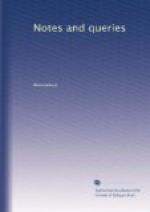Taylor’s Holy Living.—I should be obliged by any of your readers kindly informing me whether there is any and what foundation for the statement in the Morning Chronicle of Dec. 27th last, that that excellent work, Holy Living, which I have always understood to be Bishop Taylor’s, “is now known” (so says a constant reader) “not to be the production of that great prelate, but to have been written by a Spanish friar. On this account it is not included in the works of Bishop Taylor, lately printed at the Oxford University Press.” I do not possess the Oxford edition here mentioned, so cannot test the accuracy of the assertion in the last sentence but if the first part of the above extract be correct, it is, to say the least, singular that Mr. Bohn, in his recent edition of the work, should be entirely silent on the subject. I should like to know who and what is this “Spanish friar?” has he not “a local habitation and a name?”
W.R.M.
[A fraud was practised on the memory of Bishop Jeremy Taylor soon after his death, in ascribing to him a work entitled Contemplations of the State of Man in this Life, and in that which is to come, and which Archdeacon Churton, in A Letter to Joshua Watson, Esq., has shown, with great acuteness and learning, was in reality a compilation from a work written by a Spanish Jesuit, named John Eusebius Nieremberg. The treatise Holy Living and Dying is unquestionably Bishop Taylor’s, and forms Vol. III. of his works, now in the course of publication under the editorship the Rev. Charles Page Eden.]
Portrait of Bishop Henchman (Vol. iii., p. 8.).—Your correspondent Y.Y. is informed, that there is in the collection of the Earl of Clarendon, at the Grove, a full-length portrait of Bishop Henchman, by Sir Peter Lely. This picture, doubtless, belonged to the Chancellor Clarendon. Lord Clarendon, in his History of the Rebellion, b. xiii. (vol. vi. p. 540. ed. Oxford, 1826), describes the share which Dr. Henchman, then a prebendary of Salisbury, had in facilitating the escape of Charles II., after the battle of Worcester. Dr. Henchman conducted the king to a place called Heale, near Salisbury, then belonging to Serjeant Hyde, afterwards made chief justice of the King’s Bench by his cousin the chancellor.
L.
Lines attributed to Charles Yorke (Vol. ii., p. 7.).—The editor of Bishop Warburton’s Literary Remains is informed, that the lines transcribed by him, “Stript to the naked soul,” &c., have been printed lately in a work entitled The Sussex Garland, published by James Taylor, formerly an eminent bookseller at Brighton, but now removed to Newick, Sussex. The lines appear to have been written on Mrs. Grace Butler, who died at Rowdel, in Sussex, in the 86th year of her age, by Alexander Pope, but, according to Taylor, not inserted in any edition of Pope’s works. The lines will be found in the 9th and 10th Nos. of The Sussex Garland, p. 285., under “Warminghurst.”




